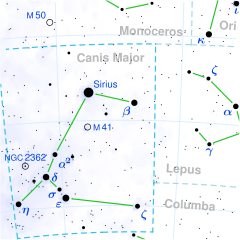Nu2 Canis Majoris
| Observation data Epoch J2000.0 Equinox J2000.0 |
|
|---|---|
| Constellation | Canis Major |
| Right ascension | 06h 36m 41.038s |
| Declination | −19° 15′ 21.17″ |
| Apparent magnitude (V) | 3.96 |
| Characteristics | |
| Spectral type | K1 III |
| Astrometry | |
| Radial velocity (Rv) | 5.39 km/s |
| Proper motion (μ) |
RA: 62.57 ± 0.15 mas/yr Dec.: −69.97 ± 0.16 mas/yr |
| Parallax (π) | 50.63 ± 0.23mas |
| Distance | 64.4 ± 0.3 ly (19.75 ± 0.09 pc) |
| Absolute magnitude (MV) | −0.05 |
| Details | |
| Mass | 1.3±0.1 M☉ |
| Radius | 4.9±0.1 R☉ |
| Luminosity | 11.3±0.1 L☉ |
| Surface gravity (log g) | 3.18±0.03 cgs |
| Temperature | 4,790±27 K |
| Metallicity [Fe/H] | 0.21±0.10 dex |
| Rotational velocity (v sin i) | 1.15 km/s |
| Age | 4.6±0.7 Gyr |
| Other designations | |
| Database references | |
| SIMBAD | data |
Nu2 Canis Majoris (ν2 CMa, ν2 Canis Majoris) is a star in the constellation Canis Major. It is an evolved K-type giant approximately 65 light years away, seen below Sirius. Around 1.5 times as massive as the Sun, it has expanded to around 2.3 times the Sun's diameter and 11 times its luminosity. In 2011, it was discovered to have a planet.
In Chinese astronomy, ν2 Canis Majoris is called 野雞, Pinyin: Yějī, meaning Wild Cockerel, because this star is marking itself and stand alone in Wild Cockerel asterism, Well mansion (see : Chinese constellation). 野雞 (Yějī), westernized into Ya Ke. According to R.H. Allen opinion, the name Ya Ke is asterism consisting ο1 Canis Majoris and π Canis Majoris, with other small stars in the body of the Dog
...
Wikipedia

